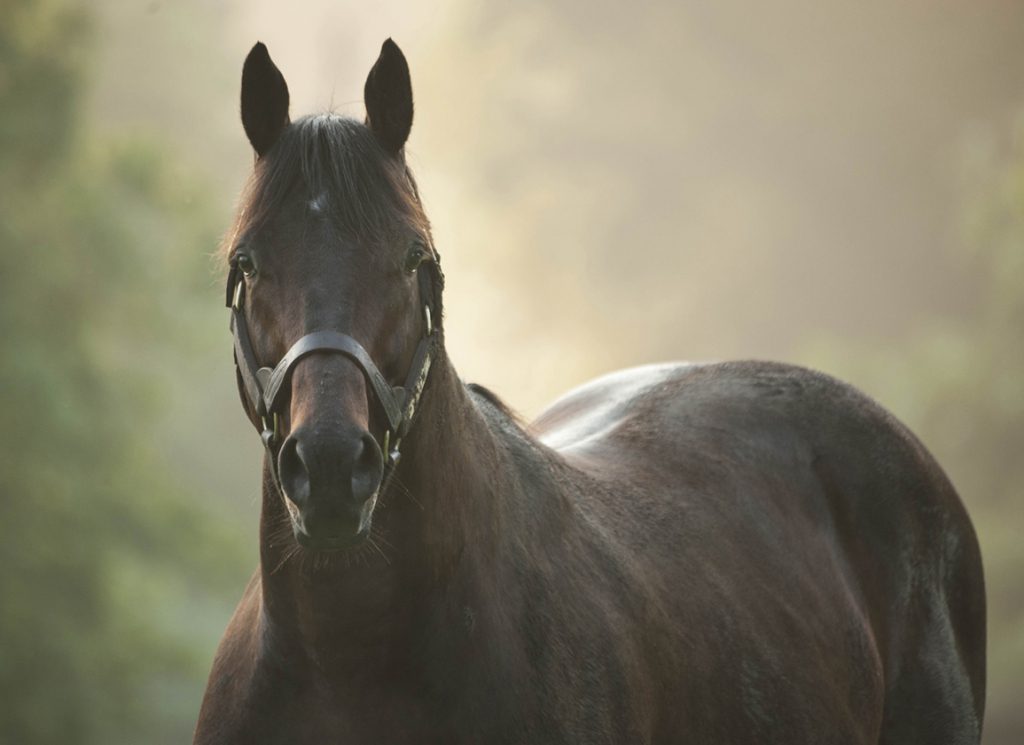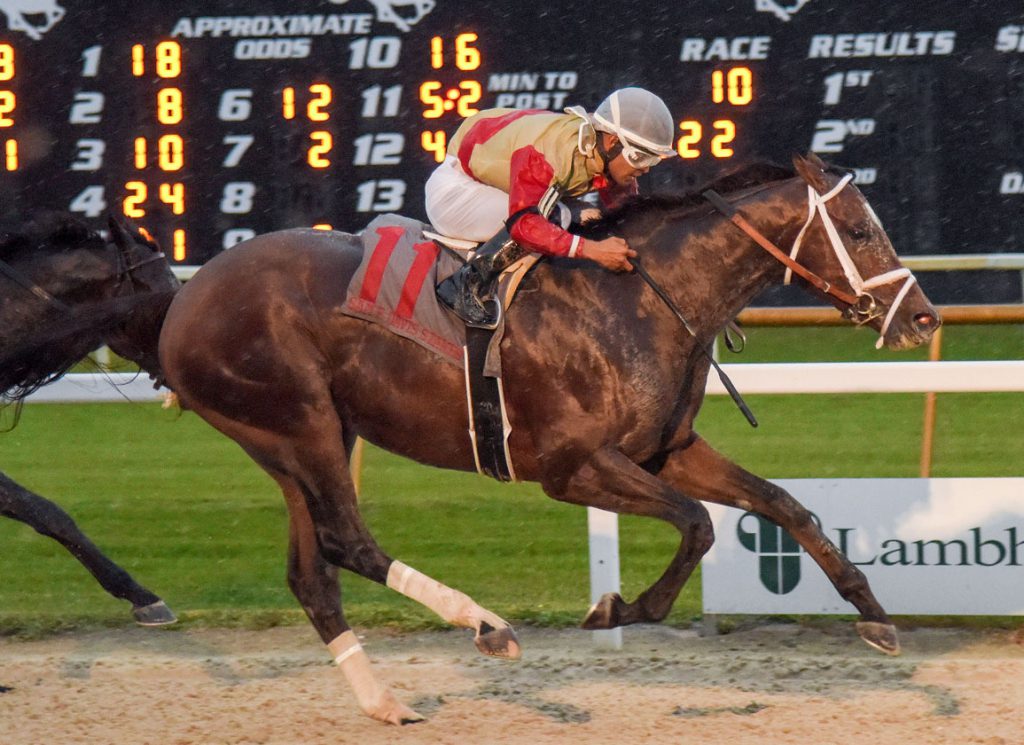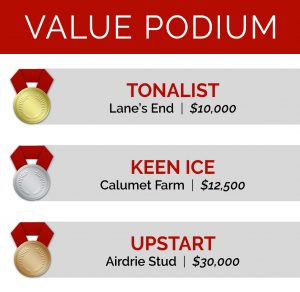With commercial sires nowadays represented by such enormous cavalries, it's unsurprising that they should encounter random statistical clusters. These tend to even themselves out, so that a stallion that “hits form” with a sudden spate of stakes performers will also endure barren spells that naturally receive rather less attention. What every farm covets, then, is for a horse to get on a roll while there are still mares out there with mating decisions pending for this spring–and there's no better way to do that than making some noise on the Classic trail.
In that context, it was a remarkable weekend. Violence accounted for the dashing winners of two Derby rehearsals; while Practical Joke, who added one for himself, followed through with two other stakes winners, one of which banked 50 starting points for the GI Kentucky Oaks. On that front, however, Girvin was the man of the hour, making a double play with trial winners on opposite coasts. Less feted, meanwhile, but perhaps most significant in the longer term, was another stellar weekend for Blame as an emerging broodmare sire.
Among all these, the obvious imperative is to consider the genetic wiring that must sustain Forte (Violence) as he stretches out in distance. Before doing so, however, it's worth acknowledging that each of these stallions has a wider momentum than mere coincidence.
Girvin had already announced himself so persuasively, in launching talented juveniles like Damon's Mound last year, that he earned an immediate transfer from Florida to Kentucky. Faiza made a key contribution to that breakout, as a spectacular pinhook ($90,000 yearling/$725,000 juvenile) who then won a Grade I on her second start, and she continued her flawless progress in the GIII Santa Ysabel S. on Sunday. Her success was rather more anticipated than that of Dorth Vader the previous day, but a filly homebred at $7,500 has now won four of six starts since stumbling on debut: a maiden, two stakes and now the GII Davona Dale S. Girvin's precocious stock, then, is consolidating in most encouraging fashion–especially given that he has so far been working with material commensurate with his opening fee. Dorth Vader, for instance, is out of a Yonaguska mare who won under a $5,000 tag in Alberta. It's going to be fun to see what Girvin can do with his upgrade at Airdrie.
Practical Joke belongs to the previous intake, meaning that he has had to deal throughout with a fairly epoch-making inconvenience in Gun Runner. As a dual Grade I-winning juvenile by into Into Mischief, he secured significant numerical opportunity at Ashford and has already had a couple of hundred individual starters. But he's taking the chance he was given, reliably slipstreaming Gun Runner in their class and already indebted to this second crop for a first Grade I success in Chocolate Gelato's Frizette last fall.
The flamboyant talent of Practical Move is offering to take his sire to another level, albeit we'll have to see quite how far he can stretch his speed. That kind of question has obviously been answered quite brilliantly by Into Mischief himself, since the elevation of his mares, and Practical Joke is making a promising early “Move” in the intensifying competition among his sons. Little Vic–from Practical Joke's debut crop–is certainly trading unapologetically in speed, and continued his fertile winter campaign with a career best in the GIII Tom Fool H. But Shidabhuti will be another looking to extend, having pried open an Oaks gate in maintaining her unbeaten start in the Busher S.
Blame is obviously a proven operator by this stage, and we've long admired his black-type output at ratios that stack up well against several more expensive covers. Indeed, this spring he has Derby and Oaks contenders himself in Litigate and Wet Paint. As a broodmare sire, however, he has barely started–and is rapidly opening up exciting horizons.
With his beautifully shaped pedigree, lining up his fourth dam Thong against his sire Arch's third dam Courtly Dee (both by sons of Nasrullah, in Nantallah and Never Bend), I've always said Blame looked a great option for someone who wouldn't mind retaining a filly. And his daughters arguably gave us both the leading juveniles of 2022, in Forte himself and Loggins (Ghostzapper); while two others produced sophomore stakes winners to sandwich the champion's comeback win last Saturday. Danse Macabre (Army Mule) won the GIII Herecomesthebride S. on the same card, while Botanical (Medaglia d'Oro) collected 20 Oaks points in the Cincinnati Trophy at Turfway. Note this well: Forte, Loggins, Danse Macabre and Botanical are all the very first foals to represent their dams on the track.
Botanical is bred on a cross akin to the one that gave us Forte, who is by a son of her sire. But while Medaglia d'Oro has long been a byword for versatility, it's conceivable that Violence may need Forte to summon the two-turn influences channelled through his dam to see out the punishing test awaiting on the first Saturday in May.
In winning the GII Fountain of Youth S., Forte was redressing his sire's narrow defeat (by the subsequent Derby winner) in the same race 10 years previously.

Medaglia d'Oro | Darley
True to the Medaglia d'Oro legacy, Violence did prove adaptable even in the span of a career that came to a premature end that day, having won the GI Hollywood Futurity on synthetics after making his name on dirt in New York. He made a flying start at Hill 'n' Dale, missing the 2017 freshman's laurels by cents (to Overanalyze!) and rewarded with 214 mares at a fee hiked from $15,000 to $25,000. With his debut crop thriving as sophomores, he proved all the rage at the yearling sales in 2018 and was raised further to $40,000. But he then mustered just two stakes winners in 2019, sending his yearling average plummeting from over $130,000 to barely $45,000. With his fee retreating to $25,000, he then turned things round with three Grade I winners in 2020, from three different crops. He was back in the game, albeit that hump in the road will tell in a somewhat diminished juvenile footprint this year (graduating from his 2020 book, which slipped to 86 mares).
Overall, after one or two wild swings early in his career, it feels safe to say that Violence has completed a process of consolidation with the emergence of Forte. Always a glossy physical, he's now up to $50,000 and already has Volatile at stud to heighten the sense that the ageing Medaglia d'Oro has belatedly organised his legacy. For quite a while, the dynasty had seemed insecure, with no heir quite matching the status of his daughters Rachel Alexandra and Songbird, or his gelded son Golden Sixty. But now he has Violence competing with a champion freshman in Bolt d'Oro, with Higher Power starting out too. Certainly anyone who consecutively replays the Fountain of Youth and then the GIII Gotham S. will observe a common swagger to Forte and Raise Cain. But that kind of natural speed is consistent with the races won by their sire's most accomplished stock to date: GI Woody Stephens S., GI Alfred G. Vanderbilt S., GI Bing Crosby S.
In vividly diversifying the legacy of turf monster El Prado (Ire), Medaglia d'Oro can also include sprint speed among his variegated resume: think Astern (Aus), Vancouver (Aus), Warrior's Reward. Quite apart from his sire-line, however, the seeding of Violence's own family also has a strong flavor of chlorophyll: his first two dams are by transatlantic influences in Gone West and Storm Cat, and the next two are by venerable European Classic influences in Blushing Groom (Fr) and Nijinsky. How curious, if these names should end up helping to create a legacy on dirt for Medaglia d'Oro.
With the help of their classic qualities, this well-known family has achieved that elusive balance between speed and stamina. Violence's third dam is Hall of Famer Sky Beauty, whose own dam was Dayjur's Grade I-winning half-sister Maplejinsky, their mother in turn being champion sprinter Gold Beauty. Bearing in mind that you'll also find Maplejinsky as third dam of Point Of Entry (Dynaformer), this maternal background should certainly help Violence stretch the speed he has imparted to his best stock; and he does have a Grade I winner over 10 furlongs in Argentina. Nonetheless it is a comfort for those in Forte's camp for the Derby to know that he can also draw on the resources of his dam Queen Caroline.

Blame | Claiborne Farm
Blame himself obviously offers her a bedrock. Besides extending the doughty Arch-Roberto brand, he also introduces more Nijinsky as sire of his grandam–whose celebrated mother, Special was of course by another sturdy influence in Forli (Arg). Queen Caroline is out of a Forestry mare, but the next dam is by Seattle Slew and soon tapers through three generations of Phipps-Wheatley royalty to a sister of Busher (and then to the Colonel Bradley matriarch Baby League and her legendary dam La Troienne {Fr}). Queen Caroline herself showed plenty of talent, at around a mile on turf, winning four black-type races. A couple of those were restricted to Virginia-breds, but she only missed a graded stakes podium by a neck. (Remarkably, she was the very first purchase made by Amy Moore–as a $170,000 Keeneland September yearling–to found South Gate Farm.)
Queen Caroline's dam was a sharp sort, promptly adding a listed sprint to her maiden win at two, but more importantly she was out of a half-sister to the increasingly important Storm Cat mare Contrive: not only dam of champion juvenile filly Folklore (Tiznow) (herself responsible for the mother of Japanese star Contrail (Jpn) (Deep Impact {Jpn}) but also second dam of Essential Quality (Tapit).
This all feels like a pretty strong foil to the speed hitherto trademarked by Violence. A similar exercise will be necessary, incidentally, with Raise Cain. He was bred by Rock Ridge Thoroughbreds from a Lemon Drop Kid mare who had won a sprint maiden in a light career, more significantly a half-sister to GI Breeders' Cup Ladies' Classic winner Unrivaled Belle (Unbridled's Song). The latter's daughter Unique Bella also had elite talent but remember that she operated very effectively round a single turn, despite being by Tapit.
So we'll have to see how the profile of Violence evolves as these sons seek to adapt their flair to the demands of the Triple Crown trail. Raise Cain certainly exhibited a full armory on Saturday: through the race he exuded contempt for the idea that the traffic around him might be running fast, and then devoured open ground like a horse eager for more. Admittedly his earlier work now seems to require some imaginative reinterpretation, whereas Forte is obviously a proven star already.
As has been well documented by now, as a $110,000 yearling Forte lurked an awfully long way down the list of 2021 purchases by Repole Stable and St Elias. (Certainly it was only a marginal reward for his $80,000 pinhookers, though Reiley McDonald could comfort himself with a trifecta of Eaton graduates in the GI Hopeful S.) Regardless, Violence has now put two sets of connections exactly where thousands of others had dreamed of being when the class of 2020 slithered into the straw. But if it turns out that none of them can outstay Forte, we know who else can share the Blame.
The post Forte Takes the Blame to Stay Strong appeared first on TDN | Thoroughbred Daily News | Horse Racing News, Results and Video | Thoroughbred Breeding and Auctions.






